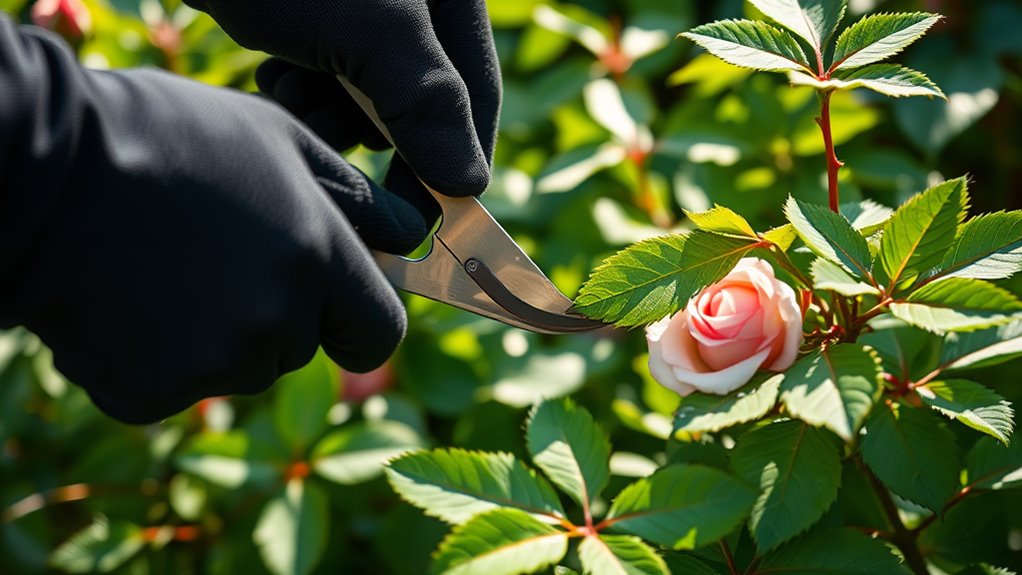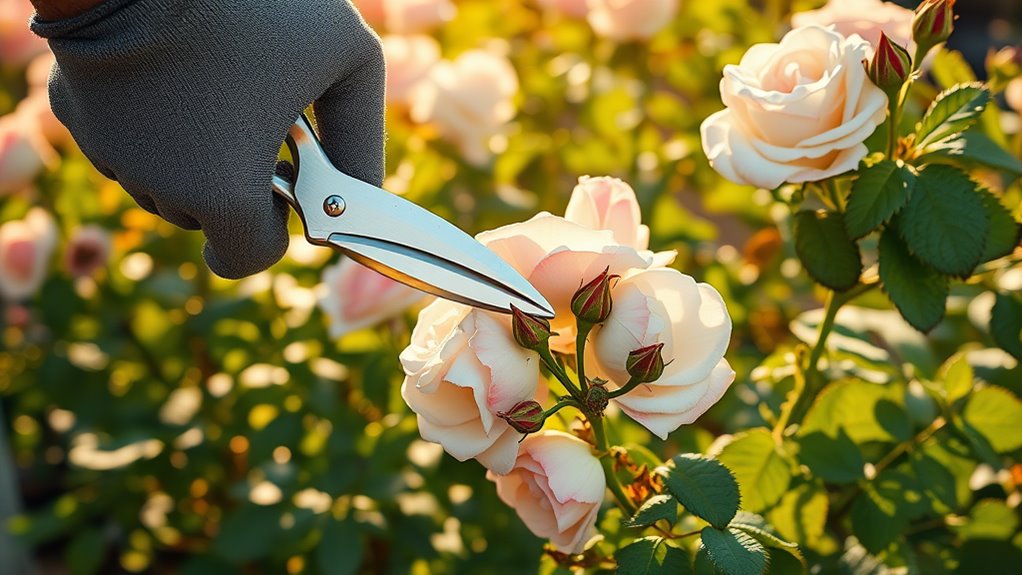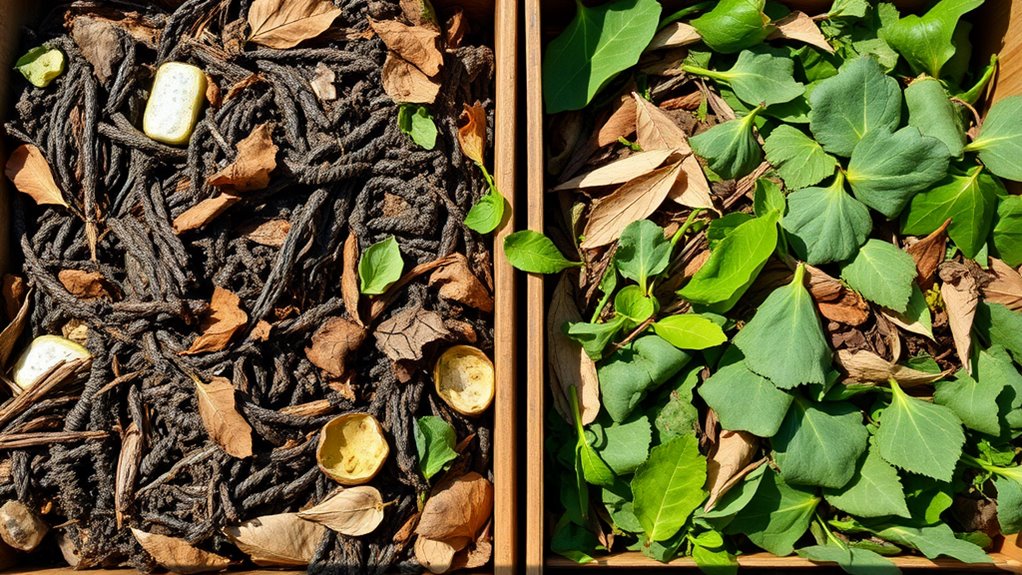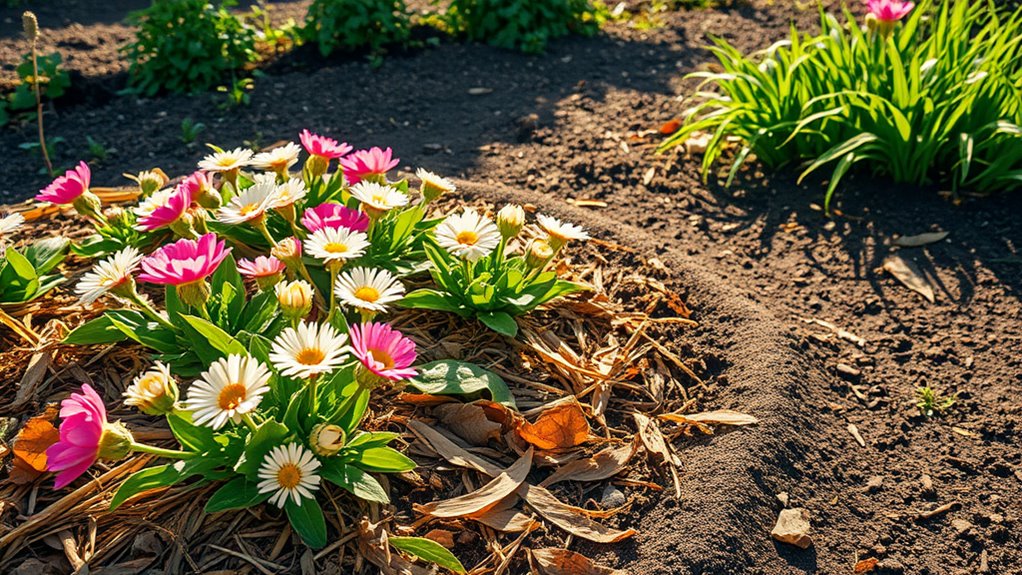The Best Way to Prune That No One Talks About
While you might not hear much about precision pruning, it’s the game-changer that boosts your plants’ blooms by up to 30% with minimal stress. Use sharp bypass shears for clean, 45-degree cuts just above buds during winter dormancy to redirect energy and improve air flow. This technique prevents diseases and enhances growth you never knew possible—keep exploring these hidden strategies for even greater garden results.
Key Takeaways
- Always test prune a small branch first to gauge the plant’s response and avoid widespread damage.
- Sanitize tools with alcohol between cuts to prevent the unnoticed spread of diseases.
- Combine pruning with soil aeration to enhance root health and accelerate recovery.
- Focus on branch collars during cuts to ensure faster healing and reduce infection risks.
- Integrate deadheading with nutrient balancing to maximize bloom potential and extend flowering seasons.
Essential Tools for Pruning Success
Pruning starts with having the right tools, as they’re key to making clean, precise cuts that promote plant health. By using these tools properly, gardeners can achieve a 50% increase in tomato yields through effective pruning.
One of pruning secrets lies in choosing sharp bypass shears for living branches, which minimize damage and disease risk. You’ll also need anvil pruners for dead wood, loppers for thicker stems up to two inches, and a curved pruning saw for larger limbs.
Keep tools sanitized with alcohol to prevent infections, and invest in sturdy gloves for safety. These essentials ensure efficient, professional results without harming your plants.
Properly equipped, these tools enable you to implement the three essential pruning techniques that significantly boost plant growth rates.
Identifying the Right Time to Prune
Knowing when to prune can greatly affect your plant’s health and growth.
You’ll need to observe seasonal cues first; for most species, winter dormancy minimizes stress, allowing clean cuts without harming new buds. Check for signs like leaf drop or bud swell to time your efforts precisely. For example, embracing a specific pruning habit can lead to healthier and more abundant plants.
Avoid pruning during active growth periods, as this can lead to disease or poor recovery. Factor in local climate too—wait for frost-free days in cooler regions.
Always test a small branch first to ensure the plant responds well, promoting vigorous regrowth without setbacks.
By applying these techniques effectively, you can enhance your gardening skills and achieve beautiful blooms.
Techniques for Different Plant Types
While every plant type demands tailored techniques, you’ll adapt your pruning methods based on growth habits and structure to promote health and vigor. This means selecting tools and cuts that suit each plant’s form, from vigorous trees to delicate flowers. However, it’s crucial to consider timing tips to dispel common misconceptions and ensure plants thrive.
-
For deciduous trees, picture selective thinning to expose sunlight, cutting just above the branch collar for seamless healing.
-
With evergreens, visualize tip pruning to encourage dense foliage, removing only new growth for natural shaping.
-
For roses, imagine deadheading spent blooms with sharp shears to spur repeat flowering and prevent disease.
-
On shrubs, think of rejuvenation by cutting back old stems at the base, opening up space for new shoots.
-
Vines require training cuts, envision tying back while snipping excess to control spread and enhance support structures.
By applying these methods consistently, gardeners can benefit from the straightforward methodology that enhances pruning skills for both novices and experts.
Hidden Benefits of Strategic Pruning
Strategic pruning not only shapes your plants effectively but also yields unexpected advantages that enhance their overall resilience.
It improves air circulation, reducing disease susceptibility and fostering healthier leaves. You’ll stimulate vigorous new growth, boosting your plants’ ability to withstand pests and environmental stress. This enhanced resilience can be further supported by natural pest control techniques.
By redirecting energy to productive areas, it increases flowering and fruit yields, optimizing resource use.
Additionally, removing dead wood prevents nutrient loss, promoting efficient water uptake and root development.
This approach strengthens your garden’s ecosystem, ensuring long-term vitality with minimal effort.
Moreover, strategic pruning can complement effective watering techniques to optimize overall plant hydration and health.
Common Mistakes to Avoid in Pruning
When you’re pruning, you might commit wrong timing errors that stress plants or over-prune them, leading to weak growth.
Don’t overlook improper tool selection, as dull or wrong-sized tools can cause unnecessary damage.
Understanding these risks helps you adopt safer techniques for healthier results.
Wrong Timing Errors
Timing errors in pruning can devastate your plants’ health, so it’s crucial to understand the common mistakes that lead to poor outcomes.
You risk weakening your plants by ignoring seasonal cues, which can invite diseases or stunt growth.
To visualize these pitfalls, consider:
- Pruning mid-summer when leaves wilt under harsh sun, exposing tender stems.
- Cutting in late fall as winds whip exposed buds into brittle submission.
- Trimming during peak bloom, causing petals to scatter like fallen confetti.
- Starting too early in spring, where new shoots attract ravenous pests.
- Delaying past the first frost, turning branches into fragile ice-laden relics.
Avoid these to keep your plants thriving.
Over-Pruning Risks
Over-pruning, where you remove too much growth at once, often leaves plants vulnerable to stress and disease.
You disrupt the plant’s energy balance, causing nutrient deficiencies and reduced photosynthesis, which slows recovery and invites pests. Excessive cuts expose inner tissues to infections, leading to dieback or permanent damage.
To prevent this, you limit removals to no more than one-third of foliage per prune, allowing time for healing.
Regularly observe your plants’ responses and prune in stages for optimal health, ensuring they thrive without unnecessary risks.
Improper Tool Selection
Selecting the wrong tools for pruning can quickly turn a simple task into a damaging ordeal, as dull blades or oversized shears crush stems instead of making clean cuts. You’ll avoid this by picking sharp, appropriate tools that ensure precise, healthy trims and prevent infections.
-
Imagine jagged tears from a dull blade ripping through your plant’s bark, exposing it to disease.
-
Picture oversized shears mangling thin branches, leaving crushed stubs that won’t heal.
-
Envision rusty tools transferring pathogens, turning a simple cut into a widespread infestation.
-
See yourself fumbling with ill-fitting handles, causing slips that damage nearby growth.
-
Think of mismatched tools like using hedge trimmers on roses, creating uneven, stressful wounds.
Advanced Methods for Healthier Plants
You’ve mastered avoiding common pruning mistakes, so now let’s explore precision pruning techniques that help you target specific branches for optimal growth.
By applying these methods, you’ll enhance your plant’s health through accurate cuts that promote healing and vigor. Additionally, incorporating mulch benefits can aid in moisture retention and pest control to support overall plant resilience.
Next, we’ll cover optimal plant revival strategies, enabling you to revive stressed plants effectively with targeted care.
To ensure your plants thrive long-term, incorporate soil preparation as a foundational step in your maintenance routine.
Precision Pruning Techniques
Precision pruning techniques help you achieve healthier plants by making targeted, calculated cuts that promote optimal growth and disease resistance.
By mastering these methods, you’re enhancing plant structure and vitality with minimal stress, using tools like sharp pruners for accuracy.
-
Envision wielding sharp bypass pruners to make clean, angled cuts that mimic natural breaks.
-
Picture identifying the branch collar precisely to encourage quick healing without stubs.
-
Imagine slicing just above a bud at a 45-degree angle, directing new growth outward.
-
Visualize thinning dense foliage to create pathways for sunlight and air flow.
-
Think of monitoring each cut closely, ensuring the plant’s energy redirects efficiently.
Optimal Plant Revival
With precise pruning techniques mastered, you tackle optimal plant revival by applying advanced methods that restore vitality to stressed or damaged plants. Focus on root stimulation, nutrient balancing, and controlled hydration to boost recovery. Start with soil aeration to enhance oxygen flow, then apply mycorrhizal fungi for better nutrient uptake.
| Method | Technique | Expected Outcome |
|---|---|---|
| Root Stimulation | Use growth hormones sparingly | Faster root development |
| Nutrient Balancing | Test and amend soil pH | Improved nutrient absorption |
| Hydration Control | Implement drip irrigation | Reduced stress, even growth |
| Fungal Inoculation | Apply beneficial microbes | Enhanced disease resistance |
These steps ensure your plants thrive efficiently.
Pruning for Maximum Bloom Potential
To maximize your plant’s bloom potential, prune strategically by focusing on deadheading spent flowers and thinning overcrowded branches, as this encourages energy redirection toward new buds and vigorous growth. Incorporating expert techniques can result in bigger and more abundant blooms throughout the growing season.
You’ll enhance flowering by removing obstacles that hinder light and nutrients.
-
Envision snipping wilted petals, freeing resources for fresh buds to emerge vibrantly.
-
Picture thinning dense limbs, allowing sunlight to filter through and invigorate hidden shoots.
-
Imagine precise cuts on crossing branches, preventing disease and promoting bold flower clusters.
-
See yourself shaping the plant, directing energy to produce larger, more colorful blooms.
-
Visualize the transformation: a garden bursting with renewed vitality and spectacular displays.
By applying deadheading techniques, you can extend the flowering period and achieve more vibrant blooms.
Signs Your Plants Need Pruning
Recognizing signs that your plants need pruning helps you maintain their health and vigor, especially after focusing on bloom-enhancing techniques.
You might spot dead or diseased branches first—these harbor pests and sap energy. Leggy growth indicates your plant’s stretching for light, signaling a need to trim back.
If foliage looks overcrowded, it restricts air flow, heightening disease risk. Watch for yellowing leaves or reduced blooms; these show nutrient diversion issues.
Crossing branches that rub create wounds, inviting infections. Early detection keeps your plants thriving and productive.
Simple Maintenance After Pruning
Once you’ve pruned your plants, focus on these straightforward steps to ensure they heal and thrive. This maintenance keeps them strong and wards off problems.
-
Water deeply but infrequently, imagining raindrops penetrating the soil to quench thirsty roots and promote recovery.
-
Inspect regularly for pests or diseases, picturing a close-up view of leaves revealing early invaders before they spread.
-
Apply mulch around the base, envisioning a barrier that locks in moisture and shields against harsh weather.
-
Use a light fertilizer, thinking of it as targeted nutrients flowing to invigorate new growth like a vital boost.
-
Monitor pruning cuts daily, visualizing them forming protective seals to prevent infection and foster healthy regrowth.





